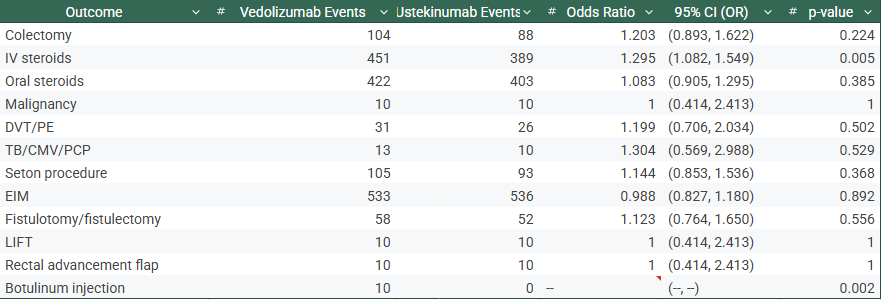Monday Poster Session
Category: IBD
P3169 - Comparative Effectiveness of Vedolizumab (Entyvio) vs Ustekinumab (Sterla) in Fistulizing Crohn’s Disease Stratified by Biologic Exposure: A Real-World Analysis
Monday, October 27, 2025
10:30 AM - 4:00 PM PDT
Location: Exhibit Hall

Rakahn Haddadin, MD
HCA Healthcare MountainView Hospital
Las Vegas, NV
Presenting Author(s)
Rakahn Haddadin, MD1, Aakriti Soni, MD2, Sushovan Guha, MD, PhD3
1HCA Healthcare MountainView Hospital, Las Vegas, NV; 2HCA Houston Healthcare Kingwood, Kingwood, TX; 3Houston Regional Gastroenterology Institute and University of Houston, Sugar Land, TX
Introduction: Vedolizumab and Ustekinumab are approved biologic agents used in the management of Crohn’s disease (CD). Limited real-world data exist comparing their efficacy in patients with fistulizing CD, especially when stratified by prior anti-TNFα exposure. This study aimed to evaluate 2-year outcomes in patients with and without previous biologic use.
Methods: Using TriNetX, two retrospective cohort analyses were conducted on patients with CD of the large intestine with fistula (ICD-10: K50.113) treated with Vedolizumab or Ustekinumab. Patients were stratified into biologic-naïve and biologic-experienced groups. Propensity score matching was applied to balance baseline characteristics. Primary outcomes included colectomy, corticosteroid use, infections (TB/CMV/PJP), malignancy, extraintestinal manifestations (EIMs), and fistula-related procedures (e.g., seton placement, fistulotomy, botulinum injection).
Results: After matching, 633 patients per arm were included in the biologic-naïve group (Table 1), and 981 per arm in the biologic-experienced group (Table 2). Across both strata, colectomy, oral steroid use, DVT/PE, TB/CMV/PJP infection, and surgical fistula interventions showed no significant differences between drugs. However, vedolizumab was associated with significantly higher use of IV steroids in both biologic-naïve (43.3% vs. 36.2%, OR 1.35, p=0.01) and biologic-experienced groups (46.0% vs. 39.7%, OR 1.30, p=0.005). In the naïve cohort, vedolizumab was linked to a lower rate of EIMs (47.4% vs. 53.2%, OR 0.79, p=0.038), whereas rates were comparable in the experienced group. Notably, botulinum injections occurred exclusively in Ustekinumab-treated naïve patients (1.6%, p=0.001) and Vedolizumab-treated experienced patients (1.0%, p=0.002), though clinical implications remain unclear.
Discussion: Vedolizumab and Ustekinumab showed similar real-world effectiveness in preventing colectomy and reducing complications in fistulizing CD regardless of biologic history. The higher steroid use in vedolizumab-treated patients may indicate differences in disease severity, time to onset of response, or therapeutic strategy. Differences in EIM rates and surgical interventions were marginal and require further investigation. These results support the individualized use of biologics in complex CD phenotypes and highlight the need for head-to-head prospective studies.

Figure: Table 1: Entyvio vs Stelara – With No Previous Biologic Exposure

Figure: Table 2: Entyvio vs Stelara – With Previous Biologic Exposure
Disclosures:
Rakahn Haddadin indicated no relevant financial relationships.
Aakriti Soni indicated no relevant financial relationships.
Sushovan Guha indicated no relevant financial relationships.
Rakahn Haddadin, MD1, Aakriti Soni, MD2, Sushovan Guha, MD, PhD3. P3169 - Comparative Effectiveness of Vedolizumab (Entyvio) vs Ustekinumab (Sterla) in Fistulizing Crohn’s Disease Stratified by Biologic Exposure: A Real-World Analysis, ACG 2025 Annual Scientific Meeting Abstracts. Phoenix, AZ: American College of Gastroenterology.
1HCA Healthcare MountainView Hospital, Las Vegas, NV; 2HCA Houston Healthcare Kingwood, Kingwood, TX; 3Houston Regional Gastroenterology Institute and University of Houston, Sugar Land, TX
Introduction: Vedolizumab and Ustekinumab are approved biologic agents used in the management of Crohn’s disease (CD). Limited real-world data exist comparing their efficacy in patients with fistulizing CD, especially when stratified by prior anti-TNFα exposure. This study aimed to evaluate 2-year outcomes in patients with and without previous biologic use.
Methods: Using TriNetX, two retrospective cohort analyses were conducted on patients with CD of the large intestine with fistula (ICD-10: K50.113) treated with Vedolizumab or Ustekinumab. Patients were stratified into biologic-naïve and biologic-experienced groups. Propensity score matching was applied to balance baseline characteristics. Primary outcomes included colectomy, corticosteroid use, infections (TB/CMV/PJP), malignancy, extraintestinal manifestations (EIMs), and fistula-related procedures (e.g., seton placement, fistulotomy, botulinum injection).
Results: After matching, 633 patients per arm were included in the biologic-naïve group (Table 1), and 981 per arm in the biologic-experienced group (Table 2). Across both strata, colectomy, oral steroid use, DVT/PE, TB/CMV/PJP infection, and surgical fistula interventions showed no significant differences between drugs. However, vedolizumab was associated with significantly higher use of IV steroids in both biologic-naïve (43.3% vs. 36.2%, OR 1.35, p=0.01) and biologic-experienced groups (46.0% vs. 39.7%, OR 1.30, p=0.005). In the naïve cohort, vedolizumab was linked to a lower rate of EIMs (47.4% vs. 53.2%, OR 0.79, p=0.038), whereas rates were comparable in the experienced group. Notably, botulinum injections occurred exclusively in Ustekinumab-treated naïve patients (1.6%, p=0.001) and Vedolizumab-treated experienced patients (1.0%, p=0.002), though clinical implications remain unclear.
Discussion: Vedolizumab and Ustekinumab showed similar real-world effectiveness in preventing colectomy and reducing complications in fistulizing CD regardless of biologic history. The higher steroid use in vedolizumab-treated patients may indicate differences in disease severity, time to onset of response, or therapeutic strategy. Differences in EIM rates and surgical interventions were marginal and require further investigation. These results support the individualized use of biologics in complex CD phenotypes and highlight the need for head-to-head prospective studies.

Figure: Table 1: Entyvio vs Stelara – With No Previous Biologic Exposure

Figure: Table 2: Entyvio vs Stelara – With Previous Biologic Exposure
Disclosures:
Rakahn Haddadin indicated no relevant financial relationships.
Aakriti Soni indicated no relevant financial relationships.
Sushovan Guha indicated no relevant financial relationships.
Rakahn Haddadin, MD1, Aakriti Soni, MD2, Sushovan Guha, MD, PhD3. P3169 - Comparative Effectiveness of Vedolizumab (Entyvio) vs Ustekinumab (Sterla) in Fistulizing Crohn’s Disease Stratified by Biologic Exposure: A Real-World Analysis, ACG 2025 Annual Scientific Meeting Abstracts. Phoenix, AZ: American College of Gastroenterology.
